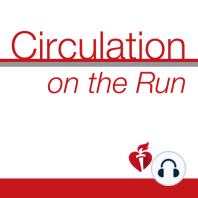17 min listen
Circulation November 1, 2016 Issue
ratings:
Length:
25 minutes
Released:
Oct 31, 2016
Format:
Podcast episode
Description
Dr. Carolyn Lam: Welcome to Circulation On The Run, your weekly podcast summary and backstage pass to the journal and its editors. I'm Dr. Carolyn Lam, Associate Editor from The National Heart Center and Duke National University of Singapore. Our interview today comes to you live from Rome at the European Society of Cardiology, where I talk to authors of The STICH Trial, about their ten year outcomes that help to answer the question, "Is there such a thing as being too old for coronary artery bypass surgery in heart failure?" But first, here's your summary of this week's journal: The first paper provides experimental evidence that hypertension may be a bone marrow disease. In this paper, first author Dr. Wang, corresponding authors Dr. Li and [Sia 00:00:50] from The First Affiliated Hospital of Dalian Medical University in China, recognize that recruitment of leukocytes from the bone marrow to the vascular wall is a key step in the development of hypertension. Numerous factors stimulate this leukocyte migration during inflammation, including chemokines, which are low molecular weight proteins of the cytokine family which activate g-protein coupled receptors and induce migration of neutrophils, monocytes, and macrophages to the damaged vascular wall. In this study the authors focus on chemokine receptor CXCR2. Using mouse models with hypertension they found that aortic MRNA levels of CXCR2 and its ligand CXCL1 are elevated in these mice with hypertension. They elegantly demonstrated that mice lacking CXCR2 are protected from blood pressure elevation, vascular inflammation of inflammatory cells, fibrosis, reactive oxygen species formation, NADPH activation and vascular dysfunction in response to either angiotensin 2 or [dolcasalt 00:02:01]. These results were recapitulated using a novel, allosteric inhibitor of CXCR2. Importantly, they also showed in 30 hypertensive patients compared to 20 normatensive controls that hypertensive patients have increased numbers of circulating CXCR2-positive cells and that there is a correlation between blood pressure and the number of CXCR2-positive cells in the circulation. In summary, these findings that CXCR2 inhibition prevents and reverses hypertension and vascular dysfunction in response to multiple hypertensive stimuli really help us to understand the mechanisms involved in CXCR2 action, but also point to a potential clinical use of CXCR2 inhibition for the treatment of hypertension. This is discussed in a beautiful accompanying editorial by Drs. [Montenel 00:02:56] and Harrison. The next study suggests that the eyes provide a window to long-term cardiovascular risk. In this paper from first author Dr. [Seidelman 00:03:12], corresponding author Dr. [Solomon 00:03:13] and colleagues from the Brigham and Women's Hospital, authors investigated whether retinal vessel calibers are associated with cardiovascular outcomes in long-term follow-up, and whether they provide incremental value over the 2013 ACCAHA pooled cohort equations in predicting atherosclerotic cardiovascular disease events. They studied 10, 470 men and women from the [Eric 00:03:41] or Atherosclerosis Risk in Community Study who underwent retinal photography at their third visit, which occurred in 1993-1995. During a mean follow-up of sixteen years, narrower retinal arterials, but wider retinal venules were associated with long-term risk of mortality and ischemic stroke in both men and women. Coronary heart disease in women was also related to narrower retinal arterials and wider retinal venules independent of the the pooled cohort equation variables. In fact, retinal vessel caliber reclassified 21% of low-risk women as intermediate-risk for atherosclerotic cardiovascular disease events. In discussing the clinical implications of these findings, the authors noticed that identification of coronary heart disease is frequently delayed in women and this under-recognition may party be due to the fact tha
Released:
Oct 31, 2016
Format:
Podcast episode
Titles in the series (100)
Circulation January 24, 2017 Issue: Circulation Weekly: Your Weekly Summary & Backstage Pass To The Journal by Circulation on the Run
